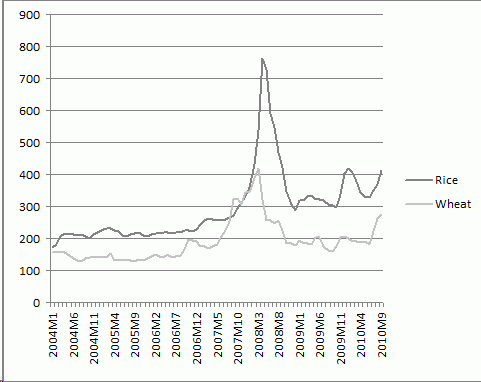Restrictions on food exports are back in the news. In 2008, food prices in international markets spiked upward, doubling in a matter of months and even more so for rice. By the end of the year, however, prices had come back down equally rapidly. Fast forward to the summer of 2010 and the international price of wheat rose by more than half, triggered by Russia’s announcement to suspend wheat exports in the wake of its drought and wildfires (Figure 1). Ukraine, Belarus, Uzbekistan, and Kazakhstan have since restricted or banned their wheat exports too, while India has effectively retained an export ban on both wheat and rice since 2008. What will become of today’s prices rises? Some argue the food crisis never really went away (see for example Conceição and Mendoza 2009 on this site).
Figure 1. International prices for rice and wheat, 2004 to 2010 (current dollars)
Source: World Bank, Pink Sheets, accessed 25 October 2010
Trade restrictions and price spikes
The recent export restrictions by Eastern Europe are bad news. By contributing to spikes in international food prices, export restrictions add to the cost of exogenous supply or demand shocks to food buyers in the rest of the world. The same is true of export subsidies, whose sudden increase in the mid-1980s (the so-called EU-North American export subsidy war) was a major contributor to the downward price spike then. Moreover, price spikes also prompt food-deficit countries to alter their import restrictions, which further exacerbates the international price spike.
This beggar-thy-neighbour behaviour of governments is a concern for all trading nations because it reduces the stability and predictability of trade opportunities. Left unchecked, it may do so even more in the future if climate change adds to the volatility of weather patterns and hence crop yields around the world.
As well as adding to international market instability, trade policy responses by exporters and importers collectively can render national government interventions ineffective at stabilising domestic prices (see recent research from two of us in Martin and Anderson 2010). . When numerous food-exporting countries increase their export restrictions in response to an exogenous shock, they further depress the terms-of-trade for food-importing countries. Should food-importing countries not want to see their domestic consumer price of food rise either, they could react by lowering their grain import tariff (or introducing an import subsidy). If they were fully successful in preventing their domestic price level from rising, they would expand world trade back to what it was before the food-exporting nations began their restrictions. This would raise the world price further, turning the terms-of-trade even more in favour of the export-taxing countries and against food-importing countries. But the net effect would be that the original objective of the exporting country – to prevent its domestic price of grain from rising in the wake of the exogenous shock – would be completely thwarted by the reaction of grain-importing countries.
Comparing 2008 with 1974
In a new paper, two of us (Anderson and Nelgen 2010) compare the extent of trade policy responses to the 2008 price spike to governments’ responses to the upward price spike around 1973-74. We do so using estimates of price distortions for many agricultural products in 75 countries from a recent World Bank research project (Anderson 2009), together with updated estimates to 2008 in the case of rice and wheat.
Trade restrictions can take many forms, and several could operate simultaneously – or remain on the legislative books but be dormant for long periods in between price spikes. Also, export taxes can be volume-based rather than ad valorem. Hence the only way to get an accurate indication of the extent to which they distort the domestic price of a product is to carefully compare domestic and border prices. Since the World Bank study confirmed that domestic producer or consumer taxes or subsidies on farm products tend to be minor relative to border measures, the distortions to consumer prices tend to be very close to the distortions to producer prices.
As a result, we are able to focus on estimates of just the nominal assistance coefficient (NAC), which is defined as the ratio of the domestic producer price to the border price (appropriately taking into account stages of processing, quality differences and so on). The price distortion is often also expressed as a percentage nominal rate of assistance (NRA), where NRA = 100 (NAC – 1), but since the NRA can be less than zero it is more convenient to use the NAC to indicate proportional changes in distortions in response to price spikes.
Of course fluctuations are to be expected in commodity markets subject to periodic supply or demand shocks, especially if adverse supply shocks occur when stocks are at low levels. They are even more likely in the presence also of sporadic changes in government storage activity or price and trade policies. Governments wanting to reduce the extent to which external shocks are transmitted to the domestic market often choose each year to pass just a fraction of any change in the international price to the domestic market. NACs would then fluctuate from year to year in the opposite direction to the international price, and will do even more so the more governments want to stabilise that product’s domestic price.
The extent to which governments do this for rice is clear from Figure 2. A more-formal way to capture this behaviour is to estimate the elasticity of transmission of an international product price change to domestic markets. We do this for 75 countries for the period 1985 to 2007. The average of estimates for the short-run elasticity range from a low of 0.3 for sugar to around 0.5 for rice, wheat, and pigmeat, just under 0.6 for cotton, cocoa, maize, and poultry, and around 0.7 for beef, soybean, and coffee. The unweighted average across all of those eleven key products is 0.54, suggesting that within the first year, little more than half the movement in international prices has been transmitted domestically over the past quarter century.
Figure 2. Nominal rate of rice assistance and the international rice price, 1970 to 2008 (left axis is the international rice price in current US dollars, right axis is the weighted average NRA where NRA = 100(NAC – 1))
(a) South Asia
Note: Correlation coefficient is -0.70. Countries included are Bangladesh (except for 1970-73), India, Pakistan and Sri Lanka.
(b) Southeast Asia
Note: Correlation coefficient is -0.57. Countries included are Indonesia (except for 1970-74), Malaysia, Philippines, Thailand and Vietnam (except for 1970-85 and 2005-08). Source: Authors’ compilation based on data in Anderson and Valenzuela (2008), updated by Anderson and Nelgen (2010).
More can be said about the role of export restrictions in particular by moving from general fluctuations in international prices to a closer examination of periods of extreme international price spikes. In Anderson and Nelgen (2010) we show that, during upward price spike years, the NACs tend to drop well below the trend estimates for the preceding non-spike period, whereas when international food prices spike downwards, as in the mid-1980s, the NACs tend to rise well above the trend in the more-normal periods either side of that spike (Table 1).
Table 1. Percentage change in NAC from previous non-spike period
|
|
Developing countries
|
High-income countries
|
|
|
1972-76
|
1984-88
|
2004-08
|
1972-76
|
1984-88
|
2004-08
|
|
|
|
|
|
|
|
|
|
Rice importers
|
-7
|
24
|
-9
|
-8
|
154
|
-50
|
|
Rice exporters
|
-14
|
31
|
-22
|
-18
|
87
|
-33
|
|
Wheat importers
|
-7
|
10
|
-22
|
-19
|
35
|
-20
|
|
Wheat exporters
|
-21
|
8
|
-14
|
-37
|
45
|
-9
|
|
Maize
|
-9
|
10
|
na
|
-12
|
18
|
na
|
|
Soybean
|
-18
|
7
|
na
|
3
|
31
|
na
|
|
Sugar
|
-44
|
35
|
na
|
-60
|
50
|
na
|
Note: Based on unweighted averages of national NACs. Source: Anderson and Nelgen (2010).
Other empirical findings in Anderson and Nelgen (2010) include the following:
- Despite considerable reform to agricultural trade policies, the insulation tendency of national governments appears to be only a little less since the mid-1980s than in the previous two decades;
- The extent and speed of NAC changes in each spike period are similar for food-exporting and food-importing countries, suggesting both types of countries actively insulate their domestic market from international food prices spikes; and
- The percentage change in the NAC was less for developing countries and more for high-income countries in the mid-1980s’ downward price-spike period than in the two upward spike periods, suggesting that in developing countries consumers are more likely to be protected from an upward price spike than producers would be from a downward price spike, and conversely in high-income countries.
The welfare implications
This pattern of intermittent border interventions, aimed at lowering the hurt to those adversely affected by an external shock even though it harms the overall economy, implies a conservative social welfare function. A more formal model of loss-averting reactions of governments, based on utility theory, has been developed by Freund and Özden (2008), building on the pioneering lobbying model of Grossman and Helpman (1994). Helpful though this may be in explaining why governments intervene, more work is needed to explain why governments attempt to provide loss-averting assistance by varying their trade restrictions rather than via more-direct and thus more efficient domestic policy instruments such as targeted income supplements to only the most vulnerable households and only while the price spike lasts.
The larger the number of countries insulating their domestic markets, the more other countries perceive a need to do likewise, exacerbating the effect on world prices such that even greater changes in trade barriers are desired by each nation – both exporters and importers. They also transfer welfare between food-surplus and food-deficit countries, and may even add to rather than reduce poverty.
Progress on international agreements
Clearly there is scope for governments to multilaterally agree to stop intermittently intervening in these ways. The World Trade Organization (WTO) is the most obvious place to seek restraints on variable trade restrictions. Indeed one of the original motivations for the Contracting Parties to sign the GATT (WTO’s predecessor) was to bring stability and predictability to world trade. To date the membership has adopted rules to encourage the use of trade taxes in place of quantitative restrictions on trade (Article IX of the GATT), and has managed to obtain binding commitments on import tariffs and on production and export subsidies as part of the Uruguay Round Agreement on Agriculture. However, those bindings have been set well above applied rates by most countries, leaving significant scope for varying them without dishonouring those legal commitments.
In the current Doha round of WTO negotiations there are proposals to phase out agricultural export subsidies as well as to bring down import tariff bindings, both of which would contribute to global economic welfare and more-stable international prices for farm products. At the same time, however, developing countries have added to the WTO’s Doha agenda a proposal for a Special Safeguards Mechanism (SSM) that would allow those countries to insulate against 85% of a decline in world prices and to raise import barriers above their current bindings for some agricultural products in the event of an international price fall or an import surge. This moves in the opposite direction to global public-good policies that would reduce the frequency and amplitude of food price spikes (Hertel et al. 2010).
Moreover, proposals to broaden the Doha agenda to also introduce disciplines on export restraints have struggled to gain traction. This reflects the facts that traditionally the demanders in WTO negotiations have been dominated by interests seeking market access, and that upward price spikes are infrequent. Yet the above analysis reveals the need for symmetry of treatment of export and import disciplines.
Could greater supply assurances from food-surplus countries, in the form of stronger disciplines on export restrictions, provide a Doha breakthrough? Potentially it could reduce the need for an safeguards mechanism, which has been one of the more contentious issues in the Doha talks and the one that triggered their suspension in mid-2008. But more than that, it could reduce the concerns that food-deficit countries have over relying on food imports in general, thereby increasing the chances of lowering not only the variance of but also the mean levels of intervention of those countries.
References
Anderson, K (ed.) (2009), Distortions to Agricultural Incentives: A Global Perspective, 1955-2007, Palgrave Macmillan and Washington DC.
Anderson, K and S Nelgen (2010), “Trade Barrier Volatility and Agricultural Price Stabilization”, Centre for Economic Policy Research, November.
Anderson, K and E Valenzuela (2008), Global Estimates of Distortions to Agricultural Incentives, 1955 to 2007, data spreadsheets at www.worldbank.org/agdistortions
Conceição, Pedro and Ronald U Mendoza (2009), “Is the global food crisis over?”, VoxEU.org, 18 April.
Freund, C and C Özden (2008), “Trade Policy and Loss Aversion”, American Economic Review 98(4):1675-1691.
Grossman, GM and E Helpman (1994), “Protection for Sale”, American Economic Review, 84(4):833-850.
Hertel, T, W Martin, and A Leister (2010), “Potential Implications of a Special Safeguard Mechanism in the World Trade Organization: The Case of Wheat”, World Bank Economic Review, 24(2):330-359.
Martin, W and K Anderson (2010), “Trade Distortions and Food Price Surges”, paper for the World Bank-UC Berkeley Conference on Agriculture for Development – Revisited, Berkeley, 1-2 October.







